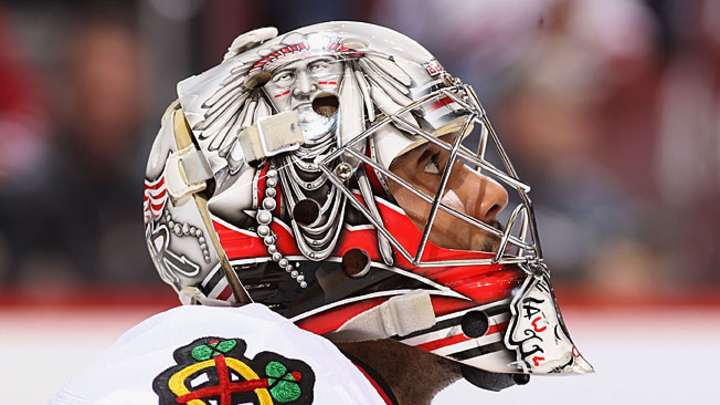Goalie Ray Emery personifies Blackhawks' revival


In the current (March 18) issue of SI magazine, Brian Cazeneuve has a feature ("The Win City") on the Chicago Blackhawks and their remarkable start to the 2013 season. From his notebook, a look at one of the team's most surprising stories....
The theme of Chicago's team is re-invention. Instead of overhauling his roster after last season's first-round playoff exit, GM Stan Bowman showed some striking faith in the players who were already there. No one is a more dramatic example than back-up goaltender Ray Emery, who this year became the first netminder in NHL history to start a season 10-0-0.
Emery was a spare part with a combustible past and any number of ways to look like a bad acquisition after he signed on with the Hawks as a free agent in October 2011. He had taken the Ottawa Senators to the Stanley Cup Final in 2007, but "Razor" as he was nicknamed had also been suspended twice for on-ice incidents and was known as a troublemaker who favored flashy clothes, cars and tattoos.
SI VAULT: The Stylish Senator Emery by Michael Farber (5/28/07)
Emery admits that he had to shoo away the hangers-on who clung to and fostered his public image.
"I wasn't opposed to that type of reputation then," he says. "But I had to learn from mistakes."
At first, he didn't. After Ottawa bought him out of his contract in 2008, his stint with Atlant Moscow Region of the KHL in 2008-09 ended after 36 games when he fought with the team trainer. When he signed with the Flyers in June 2009, he donned a mask with images of Joe Frazier, Bernard Hopkins and Rocky Balboa on it. At 6'-2", he was an agile goalie who could stop the puck, but he seemed to be one hearty conniption fit away from a wanted poster.
Emery's anger finally softened late in 2009 when he was diagnosed with avascular necrosis, a disease in which blood fails to flow to the femur, causing it to deteriorate. In April 2010, doctors removed a bone from his right fibula and sliced through his muscle to graft it to his hip. Emery slept in hourly bursts before the discomfort would shake him awake, and he later developed calluses on his armpits and hands from trying to walk with crutches.
"I had taken so much for granted until then," he says.
The scrapper eventually took to ballet, Pilates, yoga and water therapy. When he finally returned to playing shape, he signed with the Anaheim Ducks in Feb. 2011, but played in only 10 games -- going 7-2 with a 2.28 goals-against average and .926 save percentage -- before leaving as a free agent after a weak postseason performance (2-3, 3.20 GAA) as the Ducks fell in the first round.
While looking for a back-up for Corey Crawford two years ago, Bowman had to choose between Alex Salak, a Czech netminder who had a .925 save percentage in preseason action, or Emery, whose comparable numbers (.813, 4.58) were simply lousy. Emery feared the worst when Bowman gave him the verdict.
"Stan told me I was in, and not to worry about camp because he wanted me there," Emery says. "I thought, 'really?' He didn't know me that well and he had this trust in me. I couldn't tell him how grateful I was."
HACKEL: GM Bowman never doubted Crawford, either
Emery's showcase performance this season was a career-high 45-save gem in Calgary on Feb. 2 that the Hawks tied when Marian Hossa scored with 2.3 seconds left in regulation. Chicago won, 3-2, in a shootout. Quenneville later called it, "One of the best games I've seen a goalie play" and joked that someone should call the police because his goalie had stolen the game.
With Emery back in form, the rejuvenated Hawks have been able to steal wins and points on nights when they were not at their best or when the going got tight. That ability will be key down the stretch, especially if injuries to key players like Patrick Sharp start to mount.
